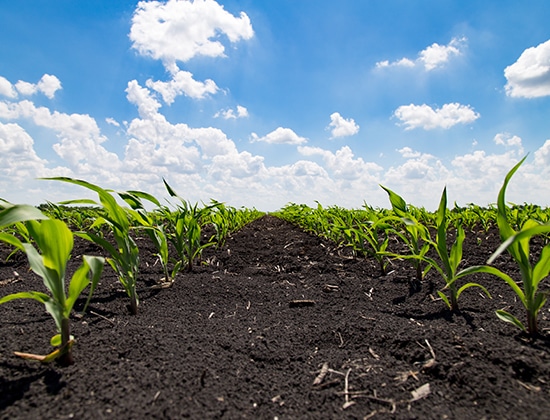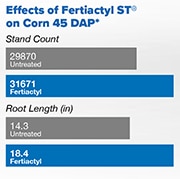Early Establishment and Stand Critical for Setting up Strong Yields >>

How to promote stand count and establishment in less than “ideal” conditions
As the race begins to get the crop in the ground, it seems that planning and preparation for planting take place a little bit earlier every year. University research supports that there are clear yield benefits for getting the seed in the ground as early as possible. However, environmental challenges seem to have squeezed the “ideal” planting window over the last few years. Tough environmental conditions can result in poor stands, low root growth, and nutrients tied up in cold soils, and other factors that can negatively impact yield.
“Achieving uniform germination can also be a challenge as we push planting dates earlier and localized weather has the potential to be cooler. For germination to occur the seed needs water. With warmer temperatures less water must be absorbed, therefore germination will start earlier and progress faster at higher temperatures. The first structure to emerge from the seed is usually the radicle (root) followed by the shoot. Growth of these structures effectively ceases at temperatures of below 48 F and above 104 F. Corn usually emerges in 8 to 10 days when soil temperatures average 60 to 64 F. It takes corn longer to emerge when soil temperatures are cooler (18-20 days at 50 to 55 F). Emergence has been known to occur in as little as 4 to 5 days when soil temperature and moisture are ideal”, explains Alexander Duffy, TIMAC AGRO USA National Product Manager.
Address early season fertility and abiotic stresses with the FERTIACTYL® Series to ensure stand count and early establishment
TIMAC AGRO USA specializes in the creation of high-efficiency fertilizer technologies. With over 60 years of research and development and its Global Innovation Center (CMI Roullier), the company is uniquely positioned to solve real world problems. For issues such as the described above, Alexander Duffy introduces the FERTIACTYL® technology platform. “FERTIACTYL seeks to work with both the soil and the plant to address early season fertility and abiotic stresses. It combines the GZA Complex with common nutrients to help with abiotic stresses, i.e. cold soils, to improve stand.”

In a study conducted on corn by Mississippi State University, FERTIACTYL® ST (a seed treatment, 1.5 oz/100lbs seed) and FERTIACTYL® GZ (Liquid Nutritional, 1.5 pts/ac at V3) where used alone as well as together to analyze their impact on corn growth, development, and yield compared to an Untreated Control.
By using intensive measurements of corn growth and yield, several findings support the use of these products in corn production. It was confirmed that early plant vigor, root growth, and stand were improved with the use of FERTIACTYL® ST up to 45 days after planting. By 90 days after planting, treatments with ST and GZ application showed the best improvements in ear length, ear diameter, and stalk diameter.
The growing conditions for 2018 were favorable for good dryland corn yields, with a period of dry weather around V5 followed by several events of excessive rains. FERTIACTYL® ST provided a better foundation at planting and in the early growth stages that provided synergy with the foliar FERTIACTYL® treatment.

Early intervention with the right technology, either as a seed treatment (FERTIACTYL® ST) or early vegetative foliar spray (FERTIACTYL® GZ @ V3) had big impacts on yields. Whether conditions are “ideal” or not, planning to overcome potential environmental challenges with technology can result in higher yields and better ROI.
Setting up for stand and crop success in 2021
Take advantage of the current ag optimism and the rising commodity prices to try our full programs and our patented technologies to reach greater results with your customers.
Volume discounts for the FERTIACTYL® series are available for bulk orders.
CLICK HERE TO TALK TO A TIMAC AGRO EXPERT
Learn more about the Fertiactyl series
